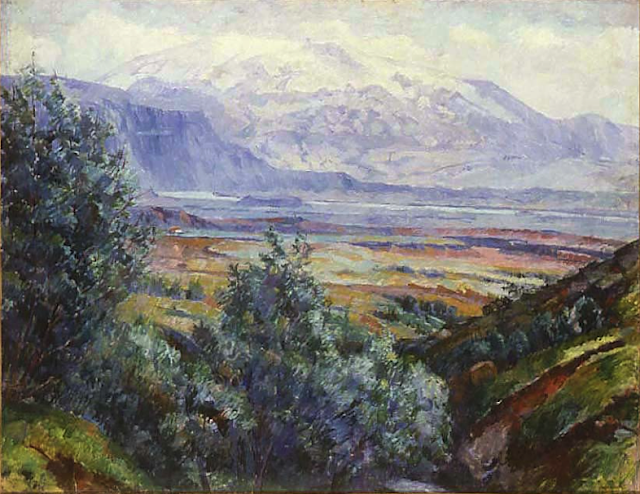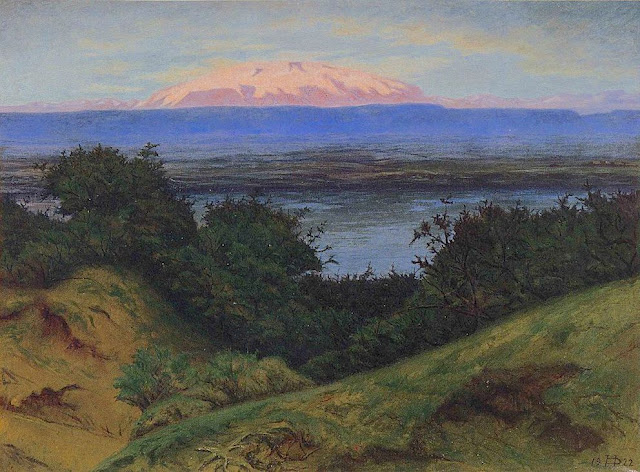%20-%20Mt%20Jarlhettur%20and%20Langjokull%20Glacier,%201928._n.jpg)
Jarlhettur (1,100m)
Islande
In Mt Jarlhettur and Langjokull Glacier, 1928, huile sur toile, National Gallery of Iceland
La montagne
Le Jarlhettur (1,100m) ou Cap du Comte en français est facilement visible dans le sud de l'Islande depuis de nombreux endroits et sous de nombreux angles. La crête mesure 15 kilomètres de long et comprend 20 montagnes dont chaque sommet est semblable à l'autre, bien que la hauteur et le diamètre diffèrent. C'est un spectacle époustoufflant que l'on peut voir en parcourant le Cercle d'Or, avec la calotte glaciaire du glacier Langjökull en arrière-plan. La direction de la crête est la même que celle de la plupart des fissures géologiques de la région, et d' Islande en général d'ailleurs : du sud-ouest au nord-est. La meilleure vue se trouve du côté est, avec le glacier Langjökull apparaissant en arrière-plan, une perspective qui intéresse toujours les photographes et les peintres. Il est assez étrange de trouver ce nom de "Comte" puisque l'Islande n'a pratiquement jamais eu de véritables artistocrates et encore moins de Comtes administrant les terres en Comtés. D’un autre côté, les Vikings islandais voyageaient beaucoup en Europe et connaissaient l'existence de comtes et des aristocrates. Géologiquement, les montagnes elles mêmes sont de nature palagonite et presque entièrement dépourvues de végétation. Les lacs et les petites rivières au pied des montagnes sont constituées des eaux glaciaires ; tout est gris et ressemble à une autre planète. Ce contraste avec bon nombre des magnifiques beautés naturelles de la nature islandaise rend la crête de Jarlhettur fascinante. La plupart des montagnes mesurent entre 800 et 900 mètres d'altitude, mais la plus haute, Tröllhetta ou Troll Cap, mesure un peu moins de 1 100 mètres.
Ásgrímur Jónsson, est un peintre islandais, l'un des premiers à vivre de son art. Il étudie à l'Académie royale des beaux-arts du Danemark entre 1900 et 1903 et voyage ensuite beaucoup à l'étranger. À partir de 1940, il s'installe pendant l'été à Húsafell, dans la région du Vesturland et nombre de ses peintures y font référence. Il y fait construire l'église actuelle.
Il est fait professeur honoraire à l'Université d'Islande, membre honoraire de l'Académie royale des arts de Suède, chevalier de l'Ordre du Dannebrog danois, et grand chevalier de l'Ordre du Faucon islandais en 1933.l
Ásgrímur est surtout connu pour ses peintures de paysages dans un style impressionniste, bien qu'il ait abordé d'autres sujets, en particulier les sagas et les histoires folkloriques. Il est également l'auteur de fresques dans plusieurs églises d'Islande.
Peu avant sa mort, il fait don au gouvernement islandais de sa maison au 74, Bergstaðastræti à Reykjavik avec toutes les œuvres en sa possession, soit 192 peintures à l'huile et 277 aquarelles, ainsi qu'un grand nombre de peintures inachevées.
_____________________________
2024 - Gravir les montagnes en peinture
Un blog de Francis Rousseau





